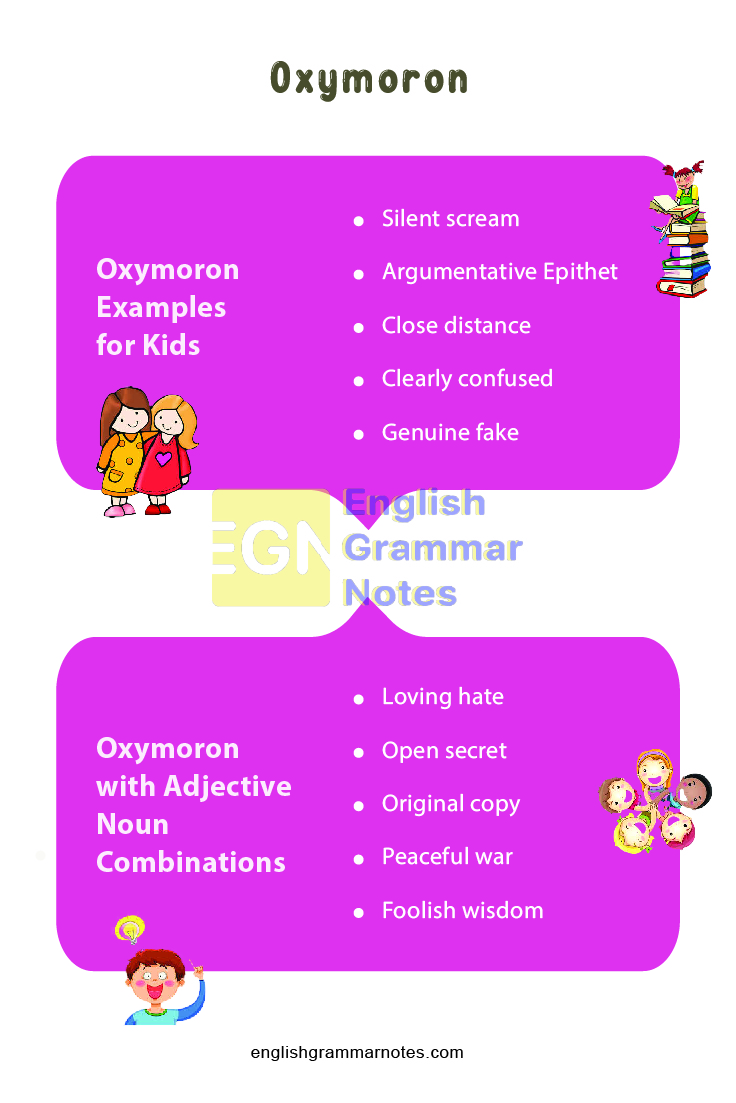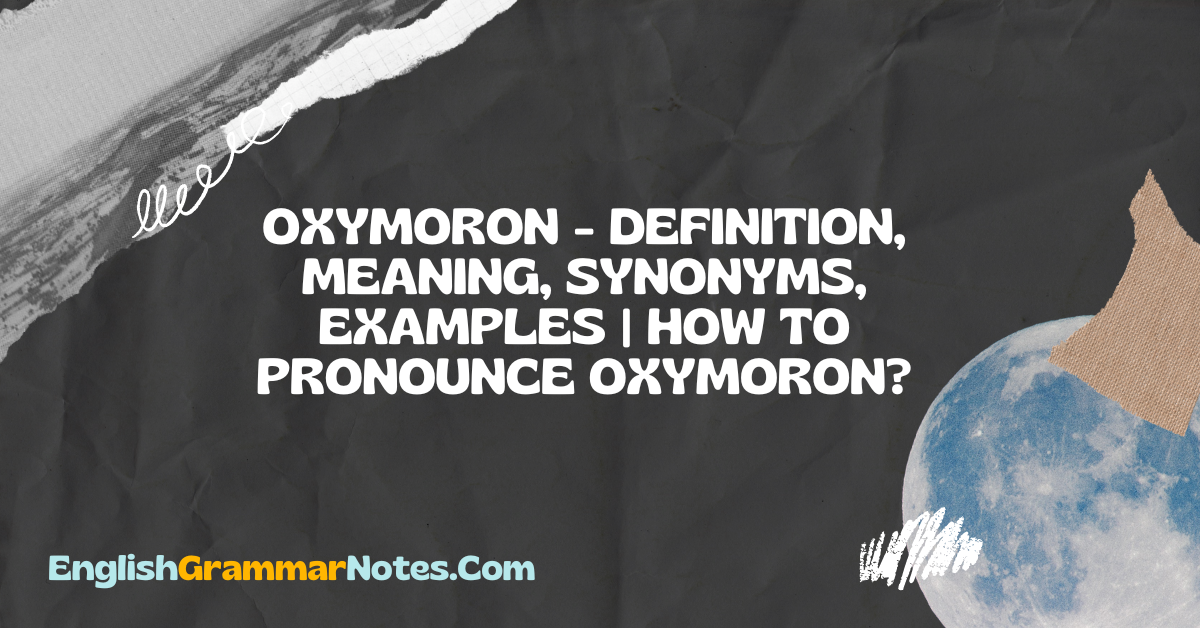An oxymoron is a figure of speech used not just in literature, but in everyday interactions as well. The word oxymoron has its root in the Greek words oxus and mōros, which implies a mix of “sharp and keen” and “dull and dumb.” In this article, we have put together all the essential information about oxymorons including their definition, common examples, their significance, etc.
- What is Oxymoron and Give Examples?
- Oxymoron Examples for Kids
- Oxymorons with Adjective Noun Combinations
- Oxymorons Containing Adverb+ Adjective/ Adverb
- Famous Oxymoron Examples
- Oxymoron Examples Sentences
- Oxymoron Vs Paradox
- Oxymoron Vs Juxtaposition
- Significance of Oxymoron
- What is an oxymoron?
- Give some examples of Oxymoron?
- Distinguish between an oxymoron and paradox?
- What are the benefits of using oxymorons?
What is Oxymoron and Give Examples?
An oxymoron is a figure of speech that pairs two opposite words together. Such combinations of opposite words are also known as contradictions. For example: take the phrase “organized mess”. Here both the words are contradictory to each other, that is something that is organized cannot be a mess. As a literary device, the oxymoron has the function of increasing the effect, enhancing the meaning, and entertaining the reader.
Oxymoron Examples for Kids
Given below is a list of the oxymorons used in everyday conversations. They are as follows
- Silent scream
- Terribly good
- Wise fool
- Close distance
- Stiff drink
- Black light
- Clearly confused
- Genuine fake
- Living history
- Exact estimate
- Quiet roar
- Student teacher
- Only choice
- Same difference
- Friendly fire
- Virtual reality
- Controlled chaos
- Freezer burn
- Passive aggressive
- Smaller half
- Magical realism
- Loyal opponent
- Random Order
- Live recording
- Jumbo shrimp
Oxymorons with Adjective Noun Combinations
The most common oxymoron occurs in the adjective-noun combination. These include
- Loving hate
- Old news
- Open secret
- Organized chaos
- Original copy
- Peaceful war
- Perfect imperfections
- Foolish wisdom
- Friendly fire
- Friendly foe
- Hateful love
- Heavy lightness
- Honest thief
- Living dead
- Loud whisper
- Random order
- Same difference

Oxymorons Containing Adverb+ Adjective/ Adverb
Given below are some examples of oxymorons that consist of an adverb and adjective or two adverbs:
- Strangely familiar
- Strangely normal
- Terribly good
- Painfully beautiful
- Perfectly imperfect
- Seriously funny
Famous Oxymoron Examples
Given below are some well-known oxymorons:
- CatDog” (American animated television series)
- “Pretty Ugly” (book by Kirker Butler
- True Lies” (American film)
- “Big Little Lies” (book by Liane Moriarty, adapted into television series for HBO)
Read More:
Oxymoron Examples Sentences
The best way to understand oxymorons is by familiarizing yourself with their use in sentences. Given below are some of the oxymorons and their usage in a sentence:
- This is a real love-hate relationship
- The joker was seriously funny
- You are clearly confused by what is happening around you.
- Can you send me the original copy?
- This is her only choice.
Oxymoron Vs Paradox
Most often you might confuse an oxymoron for a paradox. However, both these figures of speech are different. A paradox is a figure of speech where a statement appears to be contradictory but can be true. Oxymoron can be considered as a condensed paradox, that is it includes pairs of contradictory words rather than a full statement of ideas. Oxymorons can be figuratively true, but not literally true.
Oxymoron Vs Juxtaposition
Juxtaposition is the placement of two contradictory words just as an oxymoron. However, the difference is that oxymoron is a phrase containing two opposite elements, whereas juxtaposition can refer to the position of two different plot elements, characters, settings, etc. Hence oxymoron is a type of juxtaposition.
Significance of Oxymoron
The benefit of using oxymorons in your writing can be many. Given below are some of the reasons that make oxymorons important
- Oxymoron catches the reader’s attention.
- Encountering opposite words as a pair will compel the reader to engage in critical thinking.
- Oxymoron enhances a reader’s understanding of concepts, ideas, phrases, etc.
- The use of oxymorons helps you demonstrate your linguistic skills.
- Oxymorons can enhance the drama in a text.
- Indicates irony and creates humor in a work.
FAQs on Oxymoron
An oxymoron is a figure of speech that pairs two opposite words together. Such combinations of opposite words are also known as contradictions.
2. Give some examples of Oxymorons?
Some common examples of oxymorons include Exact estimate, Quiet roar, Student-teacher, Only choice, Same difference, Friendly fire, Virtual reality, etc.
3. Distinguish between an oxymoron and paradox?
A paradox is a figure of speech where a statement appears to be contradictory but can be true. Oxymoron can be considered as a condensed paradox, that is it includes pairs of contradictory words rather than a full statement of ideas. Oxymorons can be figuratively true, but not literally true.
4. What are the benefits of using oxymorons?
Oxymoron is a figure of speech that has several benefits. These include: oxymorons will compel the reader to engage in critical thinking, it enhances a reader’s understanding of s concept, ideas, phrases, etc, use of oxymoron helps you demonstrate your linguistic skills, oxymoron can also help enhance the drama, irony, and humor in a text.
Conclusion
Oxymoron is a figure of speech used in literature and everyday conversation. The use of oxymorons can be useful in catching the reader’s attention. Oxymorons can help you convey the most important idea most effectively. On the whole, oxymorons will add humor and drama to your speech and writing.
